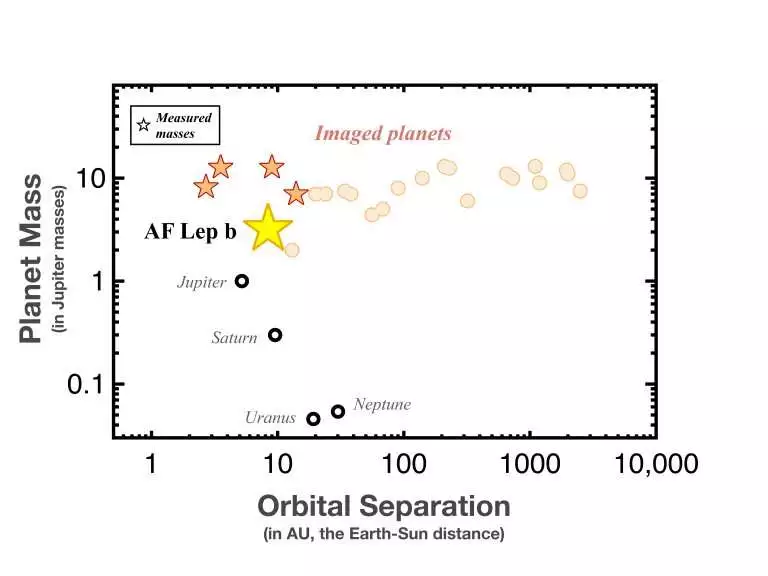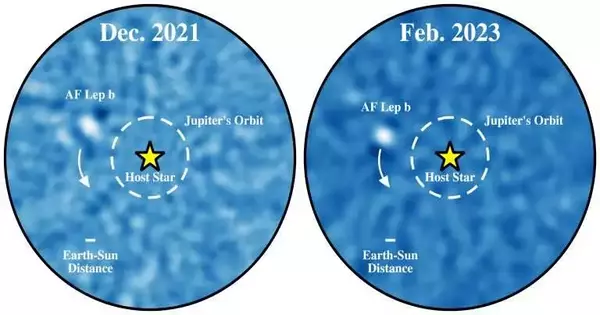One of the planets with the lowest mass whose images have been directly captured has been discovered by astronomers working with the W. M. Keck Observatory on Maunakea, Hawai’i Island. They were able to measure its mass and discover that its orbit is similar to that of the giant planets in our solar system.
Using a method known as astrometry, the planet, which is called AF Lep b, was one of the very first objects ever discovered. Astronomers can use this method to see how a host star moves over many years to see if planets or other hard-to-see companions are pulling on it by gravitational pull.
The research, which was carried out at the University of Texas at Austin (UT Austin) by graduate student in astronomy Kyle Franson, was published in The Astrophysical Journal Letters.
“This is the first time this method has been used to discover a giant planet orbiting a young sun analog. This opens the door to employing this method as a new tool for discovering exoplanets.”
Brendan Bowler, an assistant professor of astronomy at UT Austin
Franson stated, “The planet immediately popped out and became increasingly apparent the longer we observed when we processed the observations using the Keck II telescope in real time to carefully remove the glare of the star.”
Franson’s team’s direct images showed that AF Lep b orbits AF Leporis, a young sun-like star located 87.5 light-years away, and has a mass about three times that of Jupiter. Beginning in December 2021, they took a series of detailed images of the planet. Since then, two additional teams have also taken pictures of the same planet.
Brendan Bowler, senior author of the study and assistant professor of astronomy at UT Austin, stated, “This is the first time this method has been used to find a giant planet orbiting a young analog of the sun.” This permits the use of this strategy as a novel instrument for the discovery of exoplanets.”

The masses and orbital distances of all extrasolar planets that have been directly imaged up to this point are depicted in this chart. Five of the stars’ masses have been confirmed by astronomers, and the remaining dots’ masses have been estimated. With its mass and orbit, the newly discovered planet AF Lep b (yellow star) is one of the most Jupiter-like extrasolar planets ever observed. Credit: Brendan Bowler, University of Texas at Austin.
An orbiting planet causes a star’s position to slightly wobble around the center of mass of the planetary system despite having a much smaller mass than its host star. Astrometry deduces the existence of planets in orbit from this shift in a star’s position in relation to other stars in the sky. Based on how it had changed over the course of 25 years of observations by the Hipparcos and Gaia satellites, Franson and Bowler determined that the star AF Leporis might be home to a planet.
The UT Austin team combined the Near-Infrared Camera 2 (NIRC2) Vector Vortex Coronagraph of the Keck II Telescope with the adaptive optics system of the Keck Observatory, which suppresses light from the host star so that the planet could be seen more clearly, for a direct image of the planet. The adaptive optics system corrects for fluctuations caused by turbulence in the Earth’s atmosphere. The distance between AF Lep b and its host star is approximately eight times greater than the distance between Earth and the sun, and it is approximately 10,000 times fainter than its host star.
“Imaging planets is testing,” Franson said. “We only have about 15 examples, but we believe this new “dynamically informed” method, which was made possible by the Keck II telescope and the NIRC2 adaptive optics imaging, will be much more effective than blind surveys, which have been conducted for the past two decades.
If a planet regularly passes in front of the star, like a moth spiraling around a porch light, the two most common methods for finding extrasolar planets are to observe a slight periodic dimming of the starlight and to measure minute shifts in the frequencies of the starlight as a result of the planet pulling the star in the opposite direction from Earth. Large planets orbiting close to their host stars tend to work best for both methods, which are both indirect: We only see how the planet affects the star, not the planet itself.
Astronomers might be able to find extrasolar planets that were hard to find before using other methods because they were too far from their host star, too small, or didn’t have edge-on orbits as seen from Earth. This could be accomplished by combining direct imaging with astrometry. Another advantage of this method is that it makes it possible for astronomers to directly measure a planet’s mass, which is difficult to do with other approaches at great distances from its orbit.
“This will be an excellent target to further characterize with the James Webb Space Telescope and the next generation of large ground-based telescopes like the Giant Magellan Telescope and the Thirty Meter Telescope,” Bowler stated. “The team plans to continue studying AF Lep b.” In order to investigate this planet’s chemistry and physical properties, we are already planning more sensitive follow-up efforts at longer wavelengths.”
More information: Kyle Franson et al, Astrometric Accelerations as Dynamical Beacons: A Giant Planet Imaged inside the Debris Disk of the Young Star AF Lep, The Astrophysical Journal Letters (2023). DOI: 10.3847/2041-8213/acd6f6. iopscience.iop.org/article/10. … 847/2041-8213/acd6f6





